Osteochondrosis is the most common cause of back pain.Damage to the intervertebral discs, which underlies the development of the disease, is detected in every second person who is 40 years of age, and by the age of 50, 70% of the population is already incredible.At the same time, osteochondrosis is increasingly found in young people and even adolescents.Insurance hernia, radicolitis, brain supply disorders - all these are complications of osteochondrosis that threaten damage and often lead to damage.
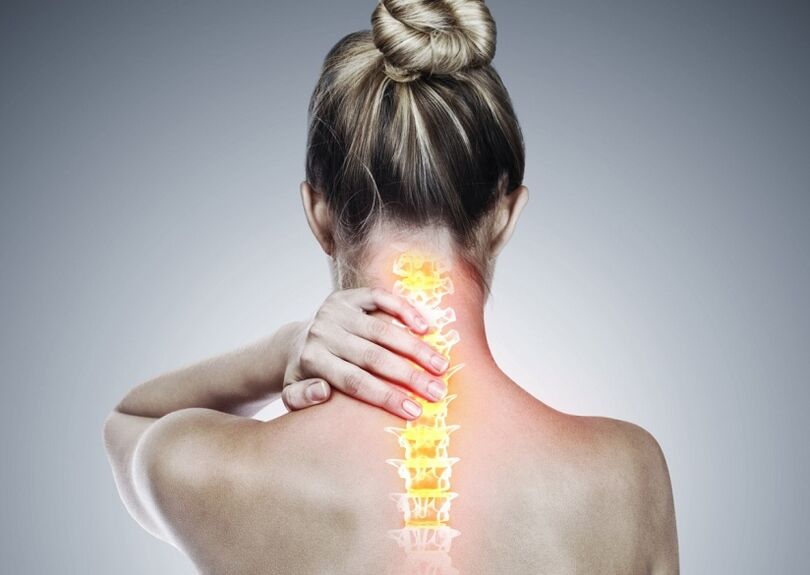
Currently, effective treatments that not only eliminate the symptoms, but also help to restore the destroyed areas of the vertebrae, there are almost no in traditional medicine.That is why it is so important to understand which factors lead to the destruction of the discs, what needs to change in their lifestyle in order to stop the development of osteochondrosis.And what measures need to be taken to deal with existing changes and to start the recovery processes in the spine.
What is osteochondrosis?How does the disease progress?
Osteochondrosis is a Disease in Which the Processes of Destruction in the Spinal -motor Segment Begin to Prevail Over the Processes of Recovery, Which Is Manifested by Pain in the Back, A Limitation ofIn the Course of the Development of This Disease, Intervertbral Hernia, Radiculitis (Radiculopathy), Ishias and Other Complications Can Form.
The intervertebral disc (called "disk") is a ring of elastic fabric whose fibers are woven into a proper and main vertebra.Due to its special structure, the intervertebral disc protects each vertebra from destruction and also ensures the mobility of the entire spine (colds, twisting).
In the center of the intervertebral disc is a pulpic nucleus, which resembles a rubber pillow filled with liquid.In an adult, it consists of 70% water, as well as carbohydrates that can bind and give water.During the load on the corresponding segment of the spine, the nucleus gives water and flattering, and after the discontinuation of the effect takes the previous form.Such a shock pillow allows the spine to spring and repay up to 80% of the shock load that comes to the spine.
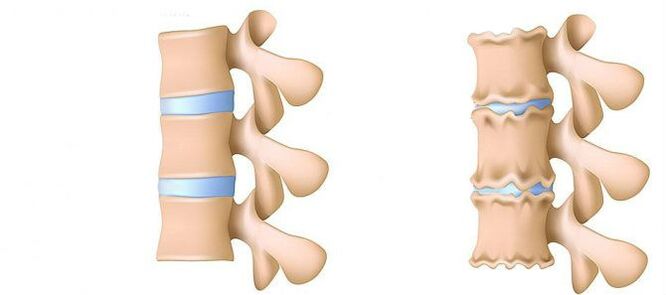
Degenerative dystrophic processes most often start with the impairment of the impact-absorbent function of the intervertebral disc.
- Worsening the blood supply to the intervertebral discSIn adults, the food of the intervertebral discs is carried out by diffusion: the blood is delivered only to the vertebrae and already through them "penetrates" the discs.In the best way, the disc is powered during dynamic loads (eg walking), since the principle of pump (leakage of processed fluid during compression, the flow of nutrients and oxygen when the load is removed).In this way, eating intervertebral discs is difficult, especially under a sedentary lifestyle (hypodinamia).
- Changes in the nucleus of amus diskSWith the deterioration of blood supply, supply of water, sugars and amino acids to the pulpulated nucleus is impaired.Therefore, the production of carbohydrates connecting water suffers.The nucleus is dehydrated, its structure, made of gel -like, becomes fibrous, the ability to provoke and burn the shots worsen.This increases the load on the fibrous ring and the vertebrae, they are more likely to be blocked and wounded.
- Changes to the fibrous ring of the intervertebral discSDue to the leveling of the pulpulated nucleus, the increased load is located on the fibrous ring of the disc.In conditions of poor blood supply, the fibrous ring loses its strength.The instability of the spine occurs, which can lead to the formation of intervertebral hernia, displacement of the vertebrae and damage to the spinal cord or nerve roots.
- ConvexSThe formation of intervertebral hernia.As the fibers of the fibrous ring weaken, the pulpitic nucleus begins to stand out, for example, to the intervertebral canal (stretches on the disc).Such shocking can further lead to a tearing of the fibrous ring and the formation of hernia.Read more about the process of formation of intervertebral hernia in a separate article - "Effective treatment of intervertebral hernia at home".
- Spondylosis - the destruction of the intervertebral joints (spondylartrosis), the growth of osteophytes and the ossification of the relationshipsSIn parallel with the formation of intervertebral hernia in osteochondrosis, damage to the intervertebral joints, destructive changes in the vertebrae (cartilage) and ligaments are observed.
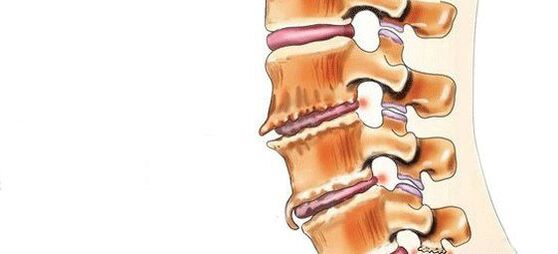
As the function of embodying the shock of the intervertebral disc is not fulfilled, the vertebrae and small intervertebral joints are constantly injured.
Spinal instability is also the cause of the cartilage damage to the vertebrae bodies and joint processes.As a result, bone tissue grows, osteophytes appear(From Greek: osteo - bone, phyto - plant)- Bone growth.The appearance of osteophytes is called a popular formation of spikes or the deposition of salts.
- Osteophytes can constantly irritate the vertebrae segment connections, which gradually leads to their ossification and to restriction of movements in the affected spine.
- Osteophytes can also injure the soft tissues nearby, the result of which is the accumulation of dead cells in them, to which the body reacts with inflammation (edema).
- The osteophytes on the surfaces of the vertebrae, facing the intervertebral discs, damage the fibers of the fibrous ring, accelerating the formation of hernia.Osteophyte that grows to the intervertebral canal enhances the compression of the spinal cord, blood vessels, and nerve roots.
- The growth of osteophytes can lead to wrapping of adjacent vertebrae and complete loss of mobility in the vertebrae segment.
Symptoms and signs
Symptoms and signs of osteochondrosis - back pain!Initially, back pain can occur due to surge of the posterior muscles that try to center excessively moving vertebrae (stage 3) so that the muscles protect the spinal cord located in the vertebrae.The spinal cord is the central part of the nervous system, so the body tries to prevent its damage (squeezing, irritation).Subsequently, the cause of the pain may already be the vertebrae of the vertebrae, hernial convexity even of a small size.During the onset of hernia, a person generally experiences severe pain (this is called cervical or lumbar ladder).

Due to the back pain, one inadvertently seeks to take a position in which the intensity of pain decreases - the so -called, forced postures.At the same time, the spine is in a non -violent position, which reduces the depreciation capabilities of the discs.This increases the risk of their more damage.
With the progress of the joints in the joints, the development of the ossification of the vertebrae bodies, the joint surfaces and the ligaments, the spine of the patient begins to lose mobility.Partial and then complete restrictions on movements in the affected spine.
Complications of osteochondrosis of the spine
There are several stages of development of complications of osteochondrosis of the spine.Their manifestations depend on the department in which the destructive process takes place.
- Disogenic Radiculitis (Radiculopathy), in which the hernial convexity drains the nerve root (a bunch of nerve fibers extending from the spinal cord and subsequently divided into nerves passing to one area or another of the body).The pain is due to both the mechanical effect of hernia on the spine and to the addition of inflammation (edema).
- Vascular brown syndrome, in which vessels are drained that feed the roots of the spinal cord.It is manifested by impaired movements in the hands (with cervical osteochondrosis) or lower limbs (with lumbosacral) as well as loss of sensitivity.With this complication, the work of the internal organs may suffer to which the affected nerves (urination, sexual function, intestinal work, etc.) go, can develop, hypertension can develop and memory impairment can develop.Sometimes the vascular disorder occurs suddenly, with a sharp movement in the affected area of the spine - more often in the lower back.There is acute pain and sudden weakening of muscles on the affected side - syndrome "paralytic".
- Disruption of blood supply to the spinal cordcaused by compression of vessels that feed the spinal cord.The exceptional degree of complication is an ischemic spinal stroke.The result of this complication is disturbed movement in the limbs (paresis, paralysis), loss of sensitivity, deterioration in the work of the internal organs until completed.In some cases, this can lead to the death of the patient, for example, when renal function suffers seriously.
Symptoms of discogenic radiculitis depend on the spine:
| Location | Symptoms and signs |
|---|---|
| Cervical, cervical-facial radiculitis | Depending on the level of damage, pain and impaired sensitivity in the neck, shoulder, forearm, fingers appear.Muscle weakness in these departments can also be observed. He often joins the neuralgia of the back nerves, in which severe pain in the back of the head is noted.Arrhythmia may occur. |
| Lumbar radiculitis | It is manifested by pain in the lower back, which is often combined with pain during the sciatic nerve - sciatica, ichradiculitis.The weakness of the leg muscles also develops, a violation of sensitivity in the thigh, lower legs and legs can occur. |
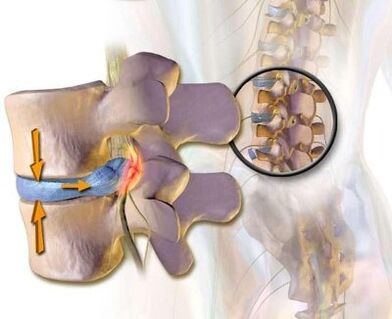
The skill of the vertebrae bodies or intervertebral discs with subsequent pressure of blood vessels and nerve roots may require urgent surgery.
The causes of the development of osteochondrosis of the spine
Osteochondrosis is called multifactorial disease - ie.There can be many reasons for its appearance.Here we will separate two key factors that gradually lead to the damage of the intervertebral discs and subsequent changes in the spine:
- Worsening in the conditions of feeding the intervertebral discs as well as cleaning their tissuesS
- Excessive spinal cord load leading to the accumulation of dead cells in the tissues of the vertebrae segmentS
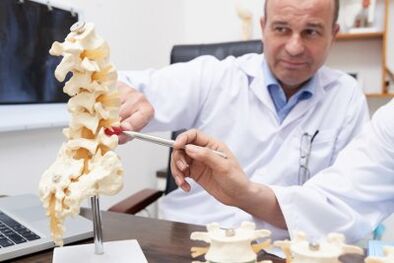
The update of the tissues of the intervertebral discs depends on the sufficiency of the blood flow and the flow of lymphatic direct to the intervertebral discs, neither the blood nor the lymphatic vessels are appropriate (which serve in the body for cleaning the tissues).Food and cleaning of the disc are indirectly, that is, slowly.This is the reason in this area to appear not only quicklyNutrient deficiency and oxygen starvationbut also quicklyDamaged and dead cells accumulateas well as developed substances.Cleaning the tissues from "slag" is necessary, otherwise there will be no room for the appearance of new functional cells and then the tissue will gradually lose its function (for example, the pulpal core of the disc will cease to spring, depreciation and will be slowly flattened).
Updating the tissues of the intervertebral discs depends on the sufficiency of the blood flow and lymphatic flow.The speed and strength of these processes are influenced by the muscles created (mainly) muscles of the muscles during physical stress.In this regard, one of the reasons for the supply and cleansing deficiency is hypodynamia when the posterior muscles are relaxed or in a static position.
With the development of osteochondrosis, blood supply, lymph and venous outflow in the spine may worsen due tomuscle spasmSThe body signals the muscles to keep the vertebrae in a certain position relative to another in the affected area.For a long time, excessive muscles press the vessels for a long time, which further sharpens the situation.
For most people, it is obvious that the spine may suffer in the event of an unusually abrupt weight lifting or when the injury, however, can be the spinal cord may be daily and not so noticeable in the event of a neuro -muscle depreciation system.Permanent microtraumas in conditions of weak lymphatic flow lead to the accumulation of dead cells, prevent the growth of functional cells and further leads to tissue ossification.
Disruption of nerve -muscle depreciation as one of the main causes of osteochondrosis
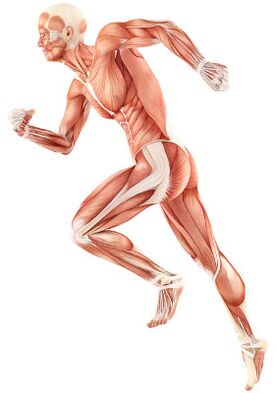
Disruption of the neuro -muscle depreciation as one of the main causes of osteochondrosis to reduce the load on the spine when walking, lifting weights, etc.The body has a whole system of neuro -muscle depreciation.It is ensured by the functioning of the nervous system of the body and skeletal muscles, which interact in accordance to provide smooth movements and to extinguish the shock loads of the bones, joints and, of course, the spine.So, most of the shock loads have to extinguish the foot.Also, the muscles of the legs and back are involved in depreciation.If this does not happen (for example, uncomfortable high collection shoes do not allow the foot to work), the intervertebral discs are subjected to shocks for which they are not intended.The factors that lead to discord in the neuromuscular depreciation system are listed below:
- Stand -up- different types of spinal curves that prevent him from "spring", the use of non -physical furniture when working in the office, etc.
- Violation of gait, Working techniques (correct when running, transfer weight from the finger to the heel);
- Wearing high -collection or heeled shoes, which negatively affects the options for depreciation of the foot.
- Excessive loads(playing sports, exhausting physical labor), traumatic joints and spine
- Obesity- excess weight displaces the center of gravity of the body, as well as fat tissue complicates the blood supply to the muscles, the behavior of nerve impulses;
- Driving in transport, sitting without depreciation (in the upright position you can provoke your feet);
- Disorders of the function of the nervous system, for example, due to the frequent use of painkillers that negatively affect the nerve conductivity.
- Renal interruptionDue to the excess, formed in the body of the decay products.This may be related to insufficient physical activity - a prerequisite for the work of the lymphatic system that is responsible for cleansing tissues of metabolic products and dead cells, as well as forliver diseases, chronic foci of inflammationetc.
Hypodynamia
One of the reasons for widespread osteochondrosis in recent decades is an epidemic of a sedentary lifestyle.The muscles of the back and press in ordinary life do not participate enough and quickly weaken, and the strong muscles are necessary for the health of the spine, which are not overloaded with static tension but are busy with dynamic work.Back muscles are the fastest weight loss with the hypody, which is filled with the following consequences:
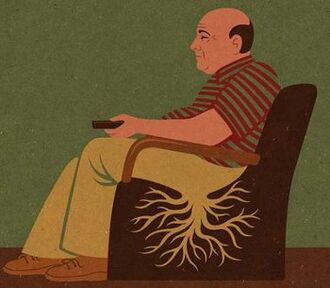
- Insufficient support for the spine in careless movements, leading to overload of the intervertebral discs, the displacement of the vertebrae and the appearance of intervertebral hernias.
- Worsening of the blood supply to the spine: The dynamic work of the skeletal muscles is a prerequisite for blood flow to any organ, including the spine.As a result of insufficient work of the back muscles, destructive changes in the intervertebral discs progress - cells die from nutrient deficiency and oxygen.And dead cells accumulate, preventing recovery.
- Worsening of the flow of lymphatic and venous outflow, which leads to the accumulation of dead cells in the tissues.The work of the skeletal muscles is especially important for the work of the lymphatic system, since most of its vessels (eg lymphocapillaries) have no muscle walls, and the "pressure" of the lymph in the blood vessels depends on the work of the skeletal muscles.
4 The principle of effective treatment
In order to eliminate not only the symptoms but also to deal with the cause of the development of osteochondrosis, spondylosis, radiculitis and needles, the following tasks must be solved:
- Create the possibilities of cleaning the tissues from dead cells.This is a prerequisite for recovery to prevent more osteophytes and release the tissue regeneration space.To do this, restore/strengthen the lymphatic flow and venous outflow from the affected segments;
- Enhancement of the blood supply to the affected area;
- Improve the tone of all the muscles that support the spine.This will allow:
- Create conditions for stimulationownblood flow and lymphatic flow in the spine;
- Restore the work of the neuro -muscle depreciation system, which is necessary for adequate spine support to prevent new damage.
- Eliminate the pain because it will allow:
- Remove muscle brackets that block blood flow to the spine;
- Avoid forced postures.
Drug (drug) therapy
Today, in the treatment of osteochondrosis and its complications, medicines from the following groups are used:
- Non -pid anti -inflammatory drugs (NSAIDs)- in the form of tablets or injections of drugs.These agents have the ability to reduce pain, to reduce the activity of inflammation.However, the effect of their use does not last long - from several hours to two to three days.Therefore, such agents should be taken for a long time - weeks and sometimes months.At the same time, these drugs adversely affect the mucous membranes of the gastrointestinal tract.Their long -term intake is fraught with the development of gastritis, ulcer lesions.In addition, they can negatively affect the work of the kidneys, liver and contribute to the development of hypertension.At the same time, these agents do not contribute to the cleansing of dead cells.Therefore, their use is only a way to relieve symptoms for some time, but not to eliminate the main problem.
- CTEPOID (GOPMONAL) anti -inflammatory drugsSAs a rule, they are used for severe and impenetrable pain, accompanying hernia, radiculitis, needles and more.Gopmoni have the ability to eliminate the manifestations of inflammation (due to the oppression of the immune system), they relieve pain.But they also adversely affect the mucous membranes of the stomach and intestines, promote the extraction of calcium from the bones, inhibit the production of their own Gopmons.And they do not contribute to the cleansing of the focus of dead cells.
- Papazmoli- Medicines that affect the muscles or nerves that go into the muscles and cause the skeletal muscles to relax.This means that they help relieve muscle brackets for some time, reduce pain and improve blood flow.But at the same time, they do not help to clean the tissues of dead cells.Therefore, they do not contribute to the treatment of osteochondrosis.
- Epidvision blockade- The introduction of painkillers and goopmonal agents in the space between the hard brain sheath and the periosteum covering the vertebrae.It is used as a rule for intense pain - in the acute period of the intervertebral hernia with severe radiculitis, needles.Depending on the composition, such an injection helps relieve the pain for several hours to several days.After the expiry date, the disease is returned, as the procedure does not help to restore the metabolic processes in the disks.In addition, when performed, there is a risk of injury to the blood vessels and nerves.
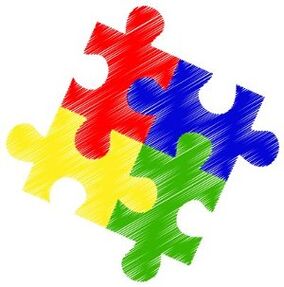
Such as osteochondrosis and the development of the progress of complicationsYou need to resort to medication more and more often, increase dosesSThis leads to high financial costs, as well as to a further deterioration of health due to the side effects of drugs.
Drug therapy is generally supplemented by immobilizing one or a friend of the spine, using orthopedic corsets of varying degrees of hardness.
























